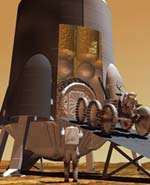
Image credit: NASA
Before humans can take the first tentative steps onto the Martian surface, our robots will have spent many years examining the planet to let us know exactly what to expect. Spirit and Opportunity will examine the dirt to see if there’s water that can be extracted. They’ll also examine the dust to see if it contains chemicals that could be detrimental to humans if it was inhaled. Robots will also help us figure out the best location humans should go to maybe mine for subsurface reserves of water or stay protected from the solar radiation.
Around the same time when Spirit?s older sister, Sojourner, was testing rover technologies on Mars during the Pathfinder mission in 1997, Mars Exploration Rover soil scientist, Doug Ming, was ?living off the martian land,? locked away in a biosphere for 30 days, sacrificing his normal life on Earth to experience ?living? on Mars. ?We simulated how astronauts would work, eat, and conduct experiments on Mars, and we even had to recycle our own urine – create purified water from it – to survive the sparse water resources on Mars,? laughed Ming.
After 15 years of researching plant growth systems and irrigation techniques for humans to use both on the Moon and Mars, Doug Ming is currently utilizing the Spirit rover to further understand the nitty-gritty composition of the dirt on Mars. His analysis will help meet the mission goal of understanding whether Gusev Crater was ever a lake. In the long term, however, studies of soil characteristics will help future scientists develop ways to extract useful materials for their colonies and safely arrive and survive on the red planet.
Humans Need Oxygen, Water, and Shelter on Mars
?In NASA?s Advanced Life Support Program, we regenerate the air by using plants to convert carbon dioxide into oxygen in closed chambers. To live safely on Mars, which has 95% carbon dioxide in its atmosphere, we?ll have to create a lot of technology tricks like that to survive,? explained Ming. Explorers visiting Mars will have to live in habitats where the oxygen is regenerated, wear spacesuits with oxygen masks, drive radiation-proof vehicles, and grow food by adding nutrients to the ?topsoil? that currently seems unable to nourish plants. But before astronauts can do all of these activities on Mars, robots need to teach humans where and how to land, where to build, and how to survive in the harsh martian environment. ?The Mini-TES instrument on Spirit is searching for water bound in soils and rocks on Mars. Water bound up in the soil and rocks could be extracted by astronauts to use as nourishment for themselves or fuel for their machines,? said Ming.
Science instruments on Spirit’s robotic arm will provide information on the martian environment that may be helpful for future human explorers.
Dirt That Hurts
?We?re also studying the chemical composition of the soil on Mars with our M?ssbauer Spectrometer and APXS instruments, which will tell us what chemicals might be detrimental to humans if they inhale the dust. For example, trace metals could be toxic to lungs, and dust could also affect electronic devices like computers and vehicles that humans will need on Mars. We?re also concerned that dust and soil could have the potential to develop electric charges. We?re taking pictures and making ?mini-movies? of dust devils that will better help us understand dust and soil movement on Mars? said Ming.
Location, Location, Location
Where should humans land on Mars? Where does enough subsurface water ice exist that humans could drill and extract? Where does the radiation penetrate the surface the least to prevent sickness and cancer-causing exposure to humans? Where is the ground strong enough to withstand a heavy human-filled mini-apartment building with parking spots for martian cars and spaceships? How do you enter the martian atmosphere with a spaceship at least thirty times larger and heavier than any spaceship humans have ever sent to Mars?
Scientists and engineers must figure out the answers to these complicated questions through the knowledge they gain from the robots sent before humans. ?Engineers and navigators will study how hot the spacecraft heat shield got as it entered the martian atmosphere, which will help future engineers model, design, and build heat shields that will ultimately protect humans as they land on Mars,? explained Ming. The The Martian Radiation Environment Experiment on NASA?s Mars Odyssey orbiter already successfully calculated that the radiation exposure on the way to Mars is twice the amount of radiation exposure that humans encounter in low-Earth orbit. Scientists are currently taking that data to model what the radiation levels would be on the surface of Mars to help build protective materials for humans during the flight to Mars and living on Mars.
Robots Pave the Way for Humans
?First and foremost, the Mars Exploration Rover mission and every mission to Mars are scientifically exciting in the present because we instantly learn about our neighboring planet. By comparing Earth to Mars, we learn more about how to protect our home planet,? said Ming. But, everything we learn now will also help us grow and evolve as explorers at exponential levels for the future. ?Space navigators still incorporate sky charts drawn by Babylonian star gazers to send spacecraft on a perfect trajectory to Mars today. Humans going to Mars – soon or even thousands of years from now – will depend on what we learn from our current robotic missions to create the right spacesuits, habitats, and roving vehicles humans will someday drive on Mars,? said Ming. ?Robots will probably even deliver our first building materials to Mars, so when humans first land, robots will have paved the way for us in more ways than one,? said Ming.
Original Source: NASA News Release
